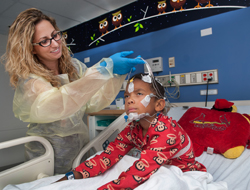What is a polysomnogram?
A polysomnogram, also known as a sleep study, is a procedure which records your child's sleeping patterns. Each study may vary depending on your child's needs and the physicians' request. Some of the recordings include:
- Brain waves -- sensors placed on the head
- Heart beat -- sensors placed on the chest
- Eye movements -- sensors placed above and below the eyes
- Leg movements -- sensors placed on the lower leg
- Breathing -- sensors placed under the nose or near the mouth
- Breathing effort and chest movement -- small belts placed around the chest and stomach
- Oxygen levels -- adhesive strip type sensor attached to the finger
 Why record all of these things?
Why record all of these things?
Your child's sleep patterns can give us valuable information. Disrupted sleep can disturb your child's daytime activities. Sometimes, medical problems involve a risk to your child's health.
Will my child sleep with all that equipment on?
Surprisingly, most children sleep well. Body sensors are applied so that your child may move freely during sleep. Sleep Center staff tries to make the sleeping area as comfortable as possible for your child. Sleep Center staff encourages parents to spend the night with the child. Once settled in bed, your child should have a good night's sleep.
Will the sensor devices hurt?
No. The sensors are applied to the skin. None of them break the skin.










